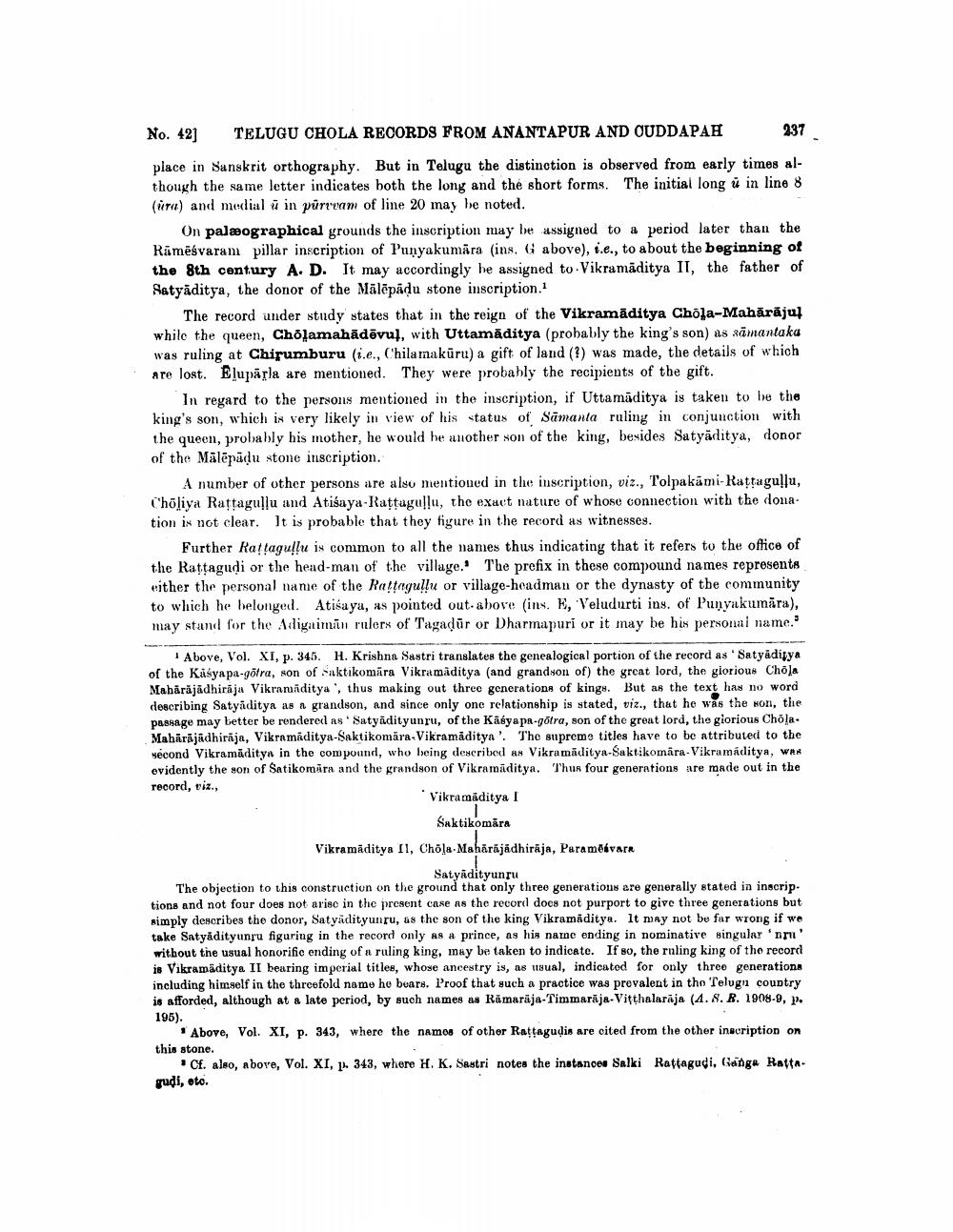________________
No. 42) TELUGU CHOLA RECORDS FROM ANANTAPUR AND QUDDAPAH 2 37 place in Sanskrit orthography. But in Telugu the distinction is observed from early times although the same letter indicates both the long and the short forms. The initial long i in line 8 (üra) and medial u in pūrivam of line 20 may be noted.
On palæographical grounds the inscription may be assigned to a period later than the Rāmēśvaram pillar inscription of Punyakumara (ins. G above), i.e., to about the beginning of the 8th century A D. It may accordingly he assigned to Vikramaditya II, the father of Satyāditya, the donor of the Mālēpādu stone inscription.
The record under study states that in the reign of the Vikramaditya Chola-Mahārājul while the queen, Cholamahädēvu), with Uttamāditya (probably the king's son) as aämantaka was ruling at Chirumburu (i.e., Chilanakūru) a gift of land (?) was made, the details of which are lost. Elupärla are mentioned. They were probably the recipients of the gift.
In regard to the persons mentioned in the inscription, if Uttamāditya is taken to be the king's son, which is very likely in view of his status of Samanta ruling in conjunction with the queen, probably his mother, he would be another son of the king, besides Satyaditya, donor of the Mālēpadu stone inscription.
A number of other persons are also mentioned in the inscription, viz., Tolpakami-Rattaguļļu, Choliya Rattagullu and Atiśaya-Rattugullu, the exact nature of whose connection with the dona. tion is not clear. It is probable that they figure in the record as witnesses.
Further Rallagullu is common to all the names thus indicating that it refers to the office of the Rattagudi or the head-man of the village. The prefix in these compound names represents either the personal name of the Raltagullu or village-headman or the dynasty of the community to which he belonged. Atisuya, as pointed out above (ins. E, Veludurti ins. of Punyakumara), may stand for the Adignimin rulers of Tagadūr or Dharmapuri or it may be his personai name.'
Above, Vol. XI, p. 345. H. Krishna Sastri translates the genealogical portion of the record as 'Satyaditya of the Kasyapa-yötra, non of eaktikomāra Vikramaditya (and grandson of) the great lord, the glorious Chola Maharajadhiraja Vikramaditya , thus making out three generations of kings. But as the text had no word describing Satyadityn as grandson, and since only one relationship is stated, viz., that he was the mon, the passage may better be rendered as Satyadityunru, of the Kasyapa-gotra, son of the great lord, the giorious Chola. Mahārājadhiraja, Vikramaditya-Saktikomara-Vikramaditya'. The supreme titles have to be attributed to the second Vikramaditya in the compound, who being described as Vikramaditya-Saktikomära-Vikramaditya, WAR evidently the son of Satikomira and the grandson of Vikramāditya. Thus four generations are made out in the record, viz.,
Vikramaditya 1
Saktikomāra Vikramaditya II, Chola-Mahārājādhiraja, Parameávarr
Satyādityunyu The objection to this construction on the ground that only three generations are generally stated in inscriptions and not four does not arise in the present case as the record does not purport to give three generations but simply describes the donor, Satyadityunru, as the son of the king Vikramaditya. It may not be far wrong if we take Satyadityunru figuring in the record only as a prince, as his name ending in nominative singular 'n without the usual honorifie ending of a ruling king, may be taken to indicate. If so, the ruling king of the record is Vikramaditya II bearing imperial titles, whose ancestry is, as usual, indicated for only three generations including himself in the threefold name he bears. Proof that such a practice was prevalent in the Telugn country is afforded, although at a late period, by such names as Ramarāja-Timmarja-Vitthalaraja (4.8. B. 1908-9, p. 195).
*Above, Vol. XI, p. 343, where the names of other Rattagudis are cited from the other inscription on this stone.
Cf. also, above, Vol. XI, 1, 343, where H. K. Sastri notes the instances Salki Rattagudi, Gonga Battarudi, oto.




